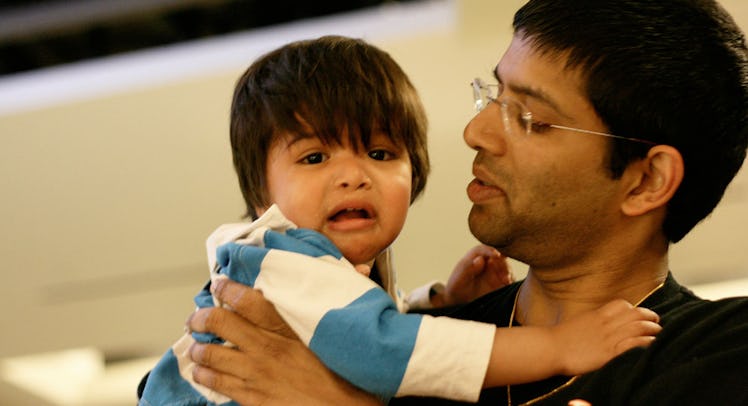The Reality Of Who Your Baby Looks To For Comfort
Relax: It's has nothing to do with your tickle skills.

For the first three months, your kid was crazy into you. You were basically the best ever. You could do no wrong. Every fart noise was on point. Each goofy tickle face was Oscar-quality. Every “going to eat your toesies” was comedy gold. But somewhere around 6 months, your kid might have started to look at you with more dispassionate tolerance than pure, unbridled joy. Particularly when they were freaked out.
You probably feel like crap because you’re now number 2 (a.k.a. The Duece, a.k.a. Not Mom). But don’t panic. It’s totally normal. Honestly.
Attachment Theory & Newborn Babies
Way back in the ’50s, a character named John Bowlby came up with this crazy idea about the way babies form attachments. His thought was that infants will tend to develop a strong psychological attachment with a primary caregiver, most often the mother (and surprisingly not that Elmo DVD you keep distracting them with).
The reason for this, Bowlby argued, was because the attachment increases the chances of the baby’s survival and comfort in the cold mean world. Not only that, but it allowed them to feel more secure to roam and explore, leading to better developmental outcomes. Though in modern times it also increases their chances of dealing with embarrassing social media baby pictures when they’re teenagers.
Why Not You?
So here’s the thing: There’s nothing in attachment theory that suggests the primary attachment figure will always be a mother. It will, however, be the person most reliable for food, care, and comfort. Researchers who came after Bowlby suggested that the attachment occurred with the person who made life easiest for the kid.
Turns out moms are really easy to get stuff from, whether it’s a bottle, some holding and rocking, or straight up loving attention. That’s because moms are super adept at picking up on the kid’s cues. Your little so-and-so doesn’t have to work as hard to get their needs met from your partner (in general). That’s mostly because they don’t yet have the dexterity to shoot you a poop emoji text to let you know their pants are full of hot mud.
Going Number 2
It’s important to note that your kid doesn’t just form that one primary attachment. In fact, Bowlby noted that babies would form a hierarchy of attachments, finding the support they need from a backup if the primary person wasn’t around. And that hierarchy hits everyone the kid comes in contact with, presumably even the ice cream guy.
In most cases the father (not the ice cream guy) winds up being the secondary attachment figure. But it doesn’t matter so much about where you are in the hierarchy as much as the quality of your kids attachment style. Attachment style is a crazy rabbit-hole that great for online pop-psychology quizzes and doctoral thesis’. It was based on the work of Mary Ainsworth who came up with the Strange Situation experiment (not to be confused with the Stranger Things experiment, which was just monstrous.)
ALSO: 5 Simple Symptoms Doctors Look for When You Drop Your Baby
The takeaway from Ainsworth’s work is that you want a kid who has a secure attachment with you no matter where you are in their hierarchy. Which is to say they get a little sad when you go, but can totally cope because they know you’ll come back. And when you do come back they’ll be stoked to see you.
The Upshot
If your kid is most often going to your partner right now, then don’t take it personally. This is absolutely a natural phase. They’ll start to diversify and understand who suits what needs best as they get older.
But also know that regardless of who your kid’s primary attachment figure is, it is the quality of any attachments that will help shape who your kid becomes. So, far from throwing up your hands and giving up. It’s important to keep responding right away to your kid when he or she is hurt or frightened or in need.
That said, make sure you can convince your partner to take some time away from the attached (sometimes literally) kid. It’s important for them to know you’re a good choice. And even if they fuss about it, it’s okay. They’ll come back to your awesome fart noises eventually.
This article was originally published on